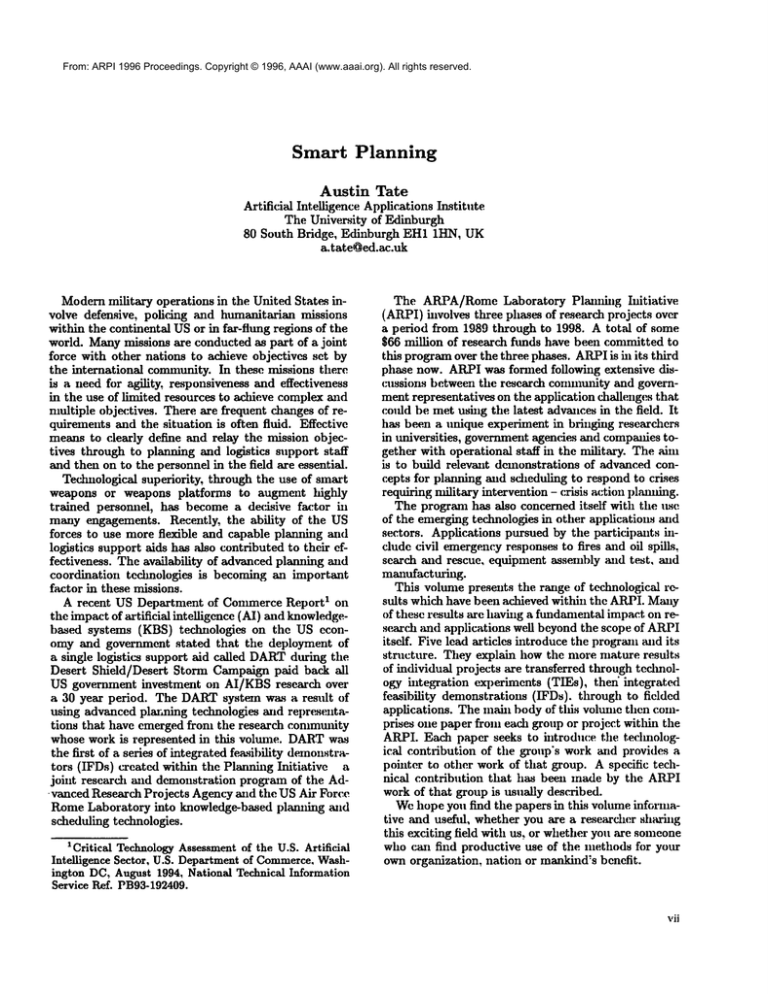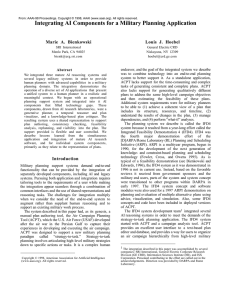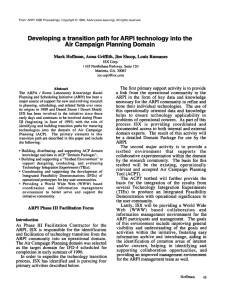
From: ARPI 1996 Proceedings. Copyright © 1996, AAAI (www.aaai.org). All rights reserved.
Smart
Planning
Austin Tate
Artificial Intelligence Applications Institute
The University of Edinburgh
80 South Bridge, Edinburgh EH1 1HN: UK
a.tate~ed.ac.uk
Modernmilitary operations in the United States involve defensive, policing and humanitarian missions
within the continental USor in far-flung regions of the
world. Manymissions are conducted as part of a joint
force with other nations to achieve objectives set by
the international community. In these missions there
is a need for agility, responsiveness and effectiveness
in the use of lindted resources to achieve complex mid
multiple objectives. There are frequent changes of requirements and the situation is often fluid. Effective
means to clearly define and relay the mission objectives through to planning and logistics support staff
and then on to the personnel in the field are essential.
Technological superiority, through the use of smart
weapons or weapons platforms to augment highly
trained personnel, has become a decisive factor in
many engagements. Recently, the ability of the US
forces to use nmre flexible and capable planning and
logistics support aids has also contributed to their effectiveness. The availability of advanced planning and
coordination technologies is becoming an important
factor in these missions.
A recent US Department of Commerce Report 1 on
the impact of artificial intelligence (AI) and knowledgebased systems (KBS) technologies on the US economy and government stated that the deployment of
a single logistics support aid called DARTduring the
Desert Shield/Desert Stornl Campaign paid back all
US government investment on AI/KBS research over
a 30 year period. The DARTsyste~n was a result of
using advanced plar.ning technologies and representations that have cmerged from the research community
whose work is represented in this volume. DARTwas
the first of a series of integrated feasibility demonstrators (IFDs) created within the Plarming Initiative
joint research mid demonstration program of the Ad¯ vanced Research Projects Agencyand the USAir Force
RomeLaboratory into knowledge-based planning ~md
scheduling technologies.
1 Critical TechnologyAssessmentof the U.S. Artificial
Intelligence Sector, U.S. Departmentof Commerce,
Washington DC, August 1994, National Technical Information
Service Ref. PB93-192409.
The ARPA/RomeLaboratory Planning Initiative
(ARPI) involves three phases of research projects over
a period from 1989 through to 1998. A total of some
$66 million of research funds have been committed to
this programover the three phases. ARPIis in its third
phase now. ARPIwas formed following extensive discussions between the research conmmnity and government representatives on the application challenges that
could be met using the latest advmmesin the field. It
has been a unique experiment in bringing researchers
in universities, governmentagencies and coInpmfies together with operational staff in the military. The aim
is to build relevant dcmonstrations of advanced concepts for pla~ming mid sdmduling to respond to crises
requiring ndlitary intervention - crisis action plmmhlg.
The progranl has also concerned itself with the use
of the emerging technologies in other applications and
sectors. Applications pursued by the participants include civil emergencyresponses to fires and oil spills,
searchtoldrescue,
equipment
assembly
multest,and
mmmfactm’ing.
This volumepresents the range of technological results which have been achieved within the ARPI. Mmly
of these results are having a fundamental impact on research ~mdapplications well beyond the scope of ARPI
itself. Five lead articles introduce the programmid its
structure. They explain how the more mature results
of individual projects are transferred through tcdmoloKy integration experiments (TIEs), then" integrated
feasibility demonstrations (IFDs). through to fielded
applications. The main body of this voluine then comprises one paper from each group or project within the
ARPI. Each paper seeks to introduce the techimlogical contribution of the group’s work and provides a
pointer to other work of that group. A specific technical contribution that has been made by the ARPI
work of that group is usually described.
Wehope you find the papers in this volume informative anduseful,
whether
youarea researcher
sharing
thisexciting
fieldwithus,or whether
youaresomeone
who can find productive use of the methods for your
own organization, nation or mankind’s benefit.
vii












